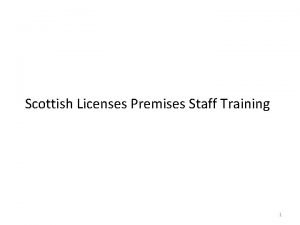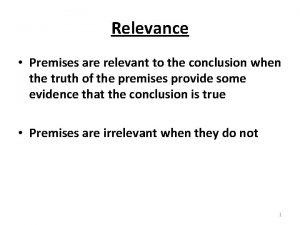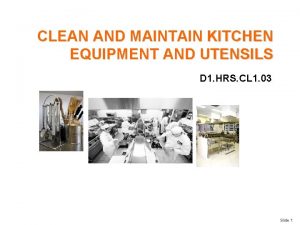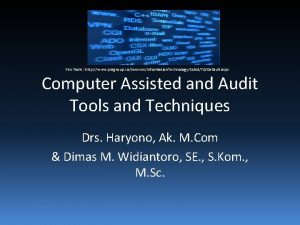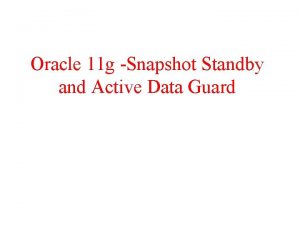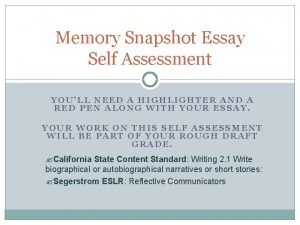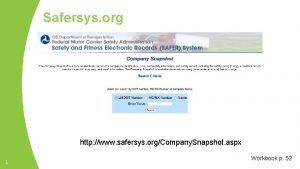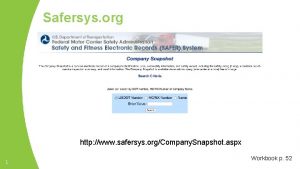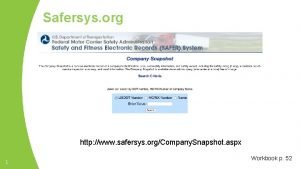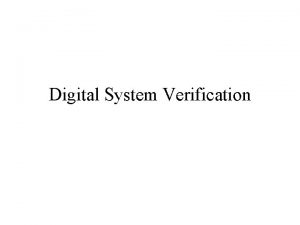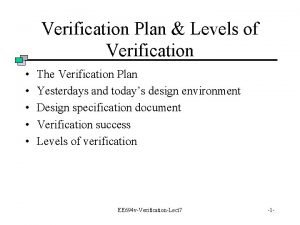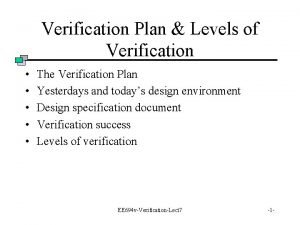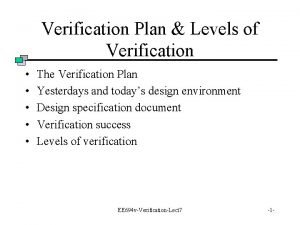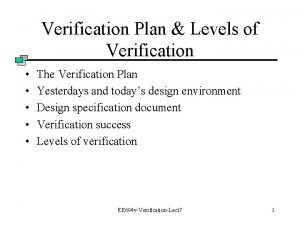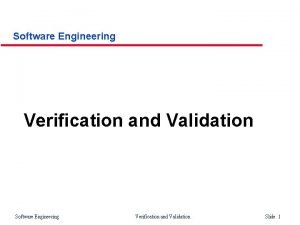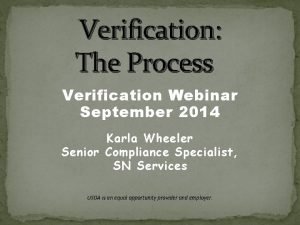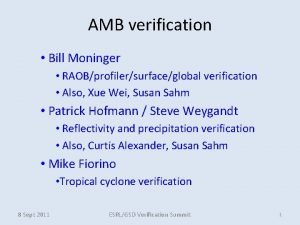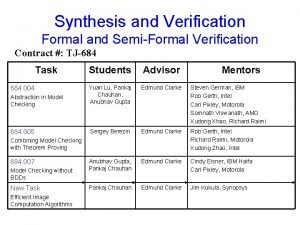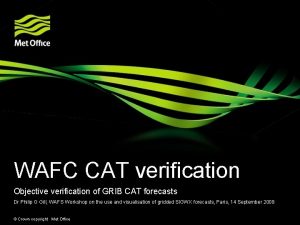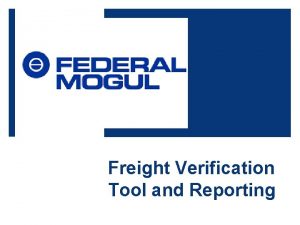Verification of premises with DG A Snapshot 1
















































- Slides: 48

Verification of premises with DG A Snapshot 1

Legislative Requirements • NSW Work. Cover is responsible for administering Dangerous Goods requirements under the OHS Act 2000. • Unlike other parts the OHS Act, Work. Cover is responsible for Public Safety as well as workplace safety when it comes to Dangerous Goods. • In 2005, Dangerous Goods notification requirements were changed. 2

DG Licensing became Notification Thresholds for Notification 10 times Emergency Plans Introduced Changes to signage implemented SEP 2005 New HAZCHEM 3

DG at non-workplaces not covered by the legislation LPG 500 L Other 2. 1 (eg acetylene) 200 L 2. 2 (eg balloon gas, medical air) 300 L Class 3 (eg. petrol, two stroke, metho) 100 L Pool Chlorine (dry PC class 5. 1) 100 kg Liquid pool chlorine (UN 1791) 100 L DG Class 9 100 kg C 1 combustible liquids 1 000 L PG I 5 kg or 5 L Any other DG (except 2. 3) 100 kg or L

Placard/Notification/Manifest Class Placard Manifest/Notify DG 99 Keep (water capacity) DG Licence (weight/vol) 2. 1 500 5 000 ranged from any amount 300 kg LPG to 60 m 3 2. 2, sub 5. 1 2 000 10 000 none Other 2. 2 5 000 10 000 none 2. 3 50 500 L ranged from any amount to 2500 kg aerosols 5 000 10 000 5 000 kg Cryogenic 1 000 10 000 60 m 3

Placard/Notification/Manifest Class PG Placard kg or L Manifest/notify kg or L DG 3 -8 I 50 500 II 250 2 500 ranged from any amount to 1000 kg or L III 1 000 10 000 III 5 000 10 000 9 no licensing except 1000 L for elevated temp liquid


DG Notification requirement … As part of the notification process an occupier is expected to undertake a risk assessment which includes: • Draw a site plan • Do an inventory of DG’s stored on site • Look at separation distances between DG • Review containment • Prepare emergency plan • Identify the proper shipping name of DG stored on site The activities undertaken as part of the notification process contribute to DG’s being stored and handled safely. Those who don’t notify don’t appear to be managing their DG risks. 8

DG Notification Data is stored on SCID Work. Cover provides Notification Data from SCID to Third Parties: • NSWFB • DECCW • NSW Planning 9

SCID Notification Data • SCID is used to provide Emergency Services with risk information on DG sites across the state. (providing inaccurate data because notifications are out of date is a risk to the emergency services. ) • Data from SCID is exported as a Mapping Layer on a monthly basis for use by Emergency Services. • DECCW use SCID Data to monitor underground Storage Tanks across state. 10

START UP SCREEN

SITE SEARCH SCREEN

Sample Printout

Sample Acknowledgement

Why is notification every 12 months important? • DG’s are a high risk to the occupier, public and the environment. • The way DG goods are stored on site may change • Staff with knowledge of DGs may leave • What is being stored onsite may change 15

What is currently on SCID (Stored Chemical Information Database) DG Notification Status Current Vs Expired • Current – 3729 – 23% • Expired – 12689 – 73% 16

Drive-Bys In February and March 2010, 92 drive by visits were conducted by Chemical team staff. The focus was to identify if sites listed as expired on SCID were still operating. (sample used post 2005 sites) • Gosford • Wagga • St Marys • Penrith 17

Post Drive-Bys Of the 92 sample sites listed as expired 83% still operating Presented to 18

Often in poor condition and or breaching safety requirements Presented to 19

Gas Depot Sites listed as expired were often of significant size and highly visible Presented to 20

Extrapolated Across SCID 12689 Expired Sites = 2919 times 83% (from sample) = 2423 sites operating illegally 21

Why is compliance with DG notification important? • The community expects that if Workcover has a legislative requirement in place, that Workcover will enforce it, particularly in high risk areas like DG. • DG notification to Workcover is required every twelve months or when there are significant changes to the site or what is stored on it. 22

Review • • • 3729 Current Notifications in SCID Evidence shows that almost 3000 notifying that should Evidence indicates those who don’t notify have unsafe sites. Emergency Services are relying on incorrect/outdated information Many inspectors no longer see DG activities as core business. This situation represents a significant Business Risk to the organisation… 23

DG Verifications • A sample of employers/sites that have notified are verified to ensure their compliance with all of their OHS obligations. • Reference to SCID database

DG Verifications • Verification includes: o Workplace visit o Documentation review o Process review o Confirmation of accuracy of information notified o Review of security issues

DG Pre-Visit • Appointment made • Management asked to make available: o Personnel o Documentation –Register, Emergency plans, Manifest, risk assessments o Time • Information sent by email: o Confirm appointment o List Clauses to be reviewed o Includes Publications

DG Verifications Verification includes: • Accuracy of notification • Manifest • Register • Spill containment • Separation • Emergency procedures • Transfer of DG • Site security • Impact protection

Manifest must include: the name of the occupier of the premises the address of the premises the date when the manifest was prepared or last amended emergency contacts for at least two people in the event of a serious incident • information about the classes and packing groups (if any) of the dangerous goods • information about dangerous goods stored in bulk, packaged goods and intermediate bulk containers (IBCs) and information about dangerous goods in processes such as manufacture. • The manifest should be kept with the emergency plan in the emergency services information cabinet at the entrances and exits to the site as agreed with the NSW Fire Brigades. • •

Manifest

Emergency Planning In case of: • Worker exposure • Fire/explosion • Spills/leaks Prepare for: • First aid/medical treatment • Evacuation • Decontamination 30

EMERGENCY PLANS

EMERGENCY PLANS

At ‘placard’ quantities: • ‘HAZCHEM’ sign at entrance to premises HAZCHEM individual signs on tanks and packages storage areas –Bulk storage placard –Packaged Dangerous Goods placard

How to placard: Outer warning placard: Bulk storage placard: Packaged goods placard: 34

Hazchem Code • Used in Australia, NZ and the UK –alternatives OS. • Australian DG Code specifies -provides Information to Emergency Services. • Number followed by 1 or more Letters

CHEMICAL REGISTERS

CHEMICAL REGISTERS * Name of substance * Hazardous Substance Yes / No Hazardous Substance Classification * Dangerous Goods Classification Location of substance Max. quantity (Class & Packaging Group) Presented to Expiry date of MSDS * Risk Assess As per MSDS/ Full risk ass Expiry date Uses 37

How to manage risk safely? • Eliminate or control the risk • Be prepared for emergencies 38

What could happen and how likely is it to happen? Two types of risk assessment: • Simple OR • Detailed 39

Presented to 40

Presented to 41

Presented to 42

Presented to 43

Presented to 44

Presented to 45

SAFETY EQUIPMENT UPGRADED

SAFETY EQUIPMENT UPGRADED BREATHING APPARATUS

SAFETY EQUIPMENT UPGRADED WIND SOCKS LEAK DETECTION SYSTEMS
 Balance sheet ib format
Balance sheet ib format Fiber to the premises
Fiber to the premises Circular letter with a tear off slip
Circular letter with a tear off slip Explicit premises
Explicit premises Extended argument
Extended argument Conclusion indicators
Conclusion indicators Explicit premises
Explicit premises Gmp premises
Gmp premises Licensed premises staff training
Licensed premises staff training Virtualized customer premises equipment
Virtualized customer premises equipment Conjoint premises
Conjoint premises Ad hominem
Ad hominem Kirk lodge approved premises
Kirk lodge approved premises Types of logical reasoning
Types of logical reasoning Information reproduced from memory can be assisted by cues
Information reproduced from memory can be assisted by cues Things we use to clean utensils
Things we use to clean utensils What the things you in cleaning kitchen premises
What the things you in cleaning kitchen premises Dynamics crm clone
Dynamics crm clone Legal aspects of catering premises
Legal aspects of catering premises 4 premises of natural selection
4 premises of natural selection Azure dsc on premises
Azure dsc on premises Safersys snapshot
Safersys snapshot Snapshot standby
Snapshot standby Snapshot
Snapshot Thoughtshot
Thoughtshot Snapshot essay example
Snapshot essay example Shortest short story ever
Shortest short story ever Ssrs snapshot
Ssrs snapshot Equipment leasing and finance industry snapshot
Equipment leasing and finance industry snapshot Snapshot dg
Snapshot dg Consider the following snapshot of a system
Consider the following snapshot of a system Microsoft
Microsoft Financialpeace.com financial snapshot
Financialpeace.com financial snapshot Snapshot reports in ssrs
Snapshot reports in ssrs Thoughtshot examples
Thoughtshot examples Equipment leasing and finance industry snapshot
Equipment leasing and finance industry snapshot The scarlet ibis similes
The scarlet ibis similes Safetsys
Safetsys Trac leases asc 842
Trac leases asc 842 Emc unity snapshot
Emc unity snapshot Snapshot
Snapshot Safersys snapshot
Safersys snapshot Snapshot study psychology
Snapshot study psychology Transport tamu
Transport tamu Safersys snapshot
Safersys snapshot Safersys company snapshot
Safersys company snapshot Safersys org company snapshot
Safersys org company snapshot Snapshot 21w11
Snapshot 21w11 Snapshot
Snapshot








